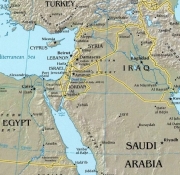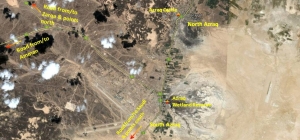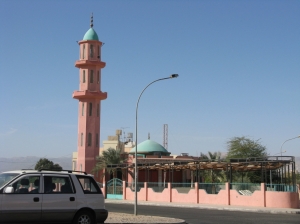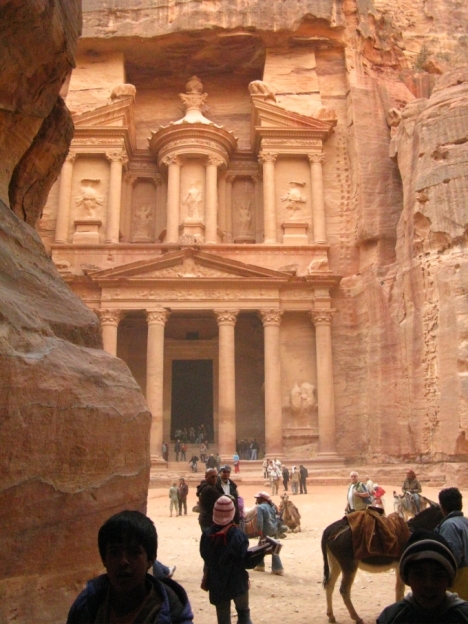The Hashemite Kingdom of Jordan is typically thought of as a desert environment … if anyone takes the chance to consider the environmental classification of this small but strategically located country. If you know anything about the geography and climatology of Jordan, then you will also know that it is one of the most water poor countries in the world, facing annual struggles to stay ahead of usage demands with meager supplies.So it may come as a surprise to you that Jordan is home to what was a vitally important, natural, regional wetland …. Azraq Oasis.
Please note that I said … “was.” It’s not that Azraq Oasis doesn’t still exist, but it is only a shadow of its former self. The Oasis used to be larger that the country of Lebanon, a gigantic blue jewel in the the otherwise barren brown-hued landscape of Northeastern Jordan. The Oasis was a haven for both humans and animals, serving as a stop for trade caravans traveling West from Baghdad and north from The Arabian Peninsula and also as a North-South rest stop for migratory birds.
Unfortunately, today only a fraction of this amazing wetlands environment remains. Why? Overuse of the precious water resource by Jordan’s developing cities in the late 1980s and the 1990s virtually annihilated the oasis. The spring that had fed the area for centuries retreated several meters underground in the 1990s. The only reason anything remains today is that the Ministry of Water pumps water back into the Oasis today in an attempt to repair the damage that was approved by a previous version of the Ministry back in the 80s when they deemed that a certain level of pumping would do no harm to the wetlands. Hindsight, as they say, is 20-20.
Despite its sad history, the Azraq Wetlands Reserve remains a jewel in the Jordanian landscape. As you drive through the open desert along highway 40 from Amman it is hard to imagine the trade caravans and legions of soldiers from every time period of recorded human history trekking through this barren landscape. Yet, this is exactly what they did. When they came over the final rise and viewed the drop down into the green and blue of the Azraq Basin it must have been a very welcome sight. It still is today … but back then it would have stretched as far as the eye could see.
Getting to Azraq from Amman
It is quite simple to get to the Azraq Wetland Preserve from Amman and takes about 1.25 to 1.5 hours depending on traffic. Thew quickest way to get there is to head south out of the city by way of Misdar Street (the road from the balad through east Amman and joins up with the airport road just south of the City). You go past Wahedat, Middle East Square/Circle, the vehicle licensing facility and just past some plant nurseries find an exit for Highway 40. I’m pretty sure that the # is not mentioned, but there are signs for Sahaab, Azraq, and Iraq. This highway will take you north and east out of Amman. You follow it for quite some time through the Eastern Desert and past a few of the Desert Castles, which are surely worth a stop if you have the time. Eventually, Highway 40 meets with Highway 30 (the route from Zarqa and points north of Amman), and a handful of kilometers later the road comes to a T-instersection in the town of Azraq. There are two parts to Azraq – North (Shemaali or Druuzi(for the Druze who once settled here)) and South (Januubi). North Azraq is to the left from the intersection and is where you will find the intriguing black basalt Azraq Castle. South Azraq is to the right from the intersection and is where you will find the entrance to the Wetland Reserve. Highway 5 connects the two parts of Azraq and runs from the Saudi border in the south up to Highway 10 that runs to the Iraqi Border in the north and east.
Error in Lonely Planet Guidebooks – I have generally found the 2006 Lonely Planet guide book to be an excellent resource for all things Jordan. The 2009 version despite expanded info on Petra and Wadi Rum is a poor attempt at an update and has a lot of inaccuracies when it comes to prices and opening times. I know this is to be expected over time, but right from the moment the new edition hit the shelves a lot of this info was wrong in the 2009 version. Although now prices are off in both, I generally find the info in the 2006 guide to be more reliable. However, both have got it wrong for the directions/maps to Azraq Castle and the Azraq Wetland Reserve.
- Azraq Castle is located off Highway 5 in North Azraq (after turning left/north at the T-Instersection of Highways 30 and 5). Just keep going through town … you can’t miss it on the left hand side. And despite the guide saying it is free, they will charge you a couple JD to get in. (.250 JD for residents)
- The entrance to The Azraq Wetland Reserve is located just east of the main road that runs through South Azraq (after turning right/south at the T-Intersection). Just follow the brown RSCN signs with the red arrows.
- Also note that the entrance fee info for the Reserve is incorrect in the guide, which states it as 2 JD. It is actually as follows: 2 JD for Jordanian Citizens, 5 JD for foreigners with Jordanian residency, 10 JD for Foreign tourists. It is worth it to help the local economy and the conservation efforts of the RSCN. But it is a bit of a sticker shock if you arrive at the reserve looking to pay 2 JD.
- The Shaumari Wildlife Reserve that is listed as a double entry on a ticket from Azraq is closed indefinitely. The RSCN employee at Azraq could not give me a time frame for when it would be open (as of December 2011).
Kudos to the RSCN

Killifish (or pupfish) species that is only found in Azraq .... almost died out, but was saved by RSCN efforts
The RSCN (Royal Society for the Conservation of Nature) has done a good job with their initial conservation efforts at Azraq. They should be applauded for saving a rare species of killifish, only found in Azraq, from extinction. They have also contributed to the survival of a herd of water buffalo – some of the only remaining large animals that once populated the oasis. Without their efforts in advocacy, the entire basin would probably now be desert, so their work should be greatly appreciated. Unfortunately the visitors center is small, as is the trail through the wetland. It only covers a fraction of the Reserve. Of course there is a delicate balance between preserving the natural environment and promoting eco-tourism, which in turn pays for the ongoing preservation efforts. My sense is tourism through this out-of-the-way part of Jordan is a bit on the light side. Perhaps there are a lot of school trips when the weather is nicer.
Well, that’s enough from me. I should just let the pictures do the rest of the talking. It should be noted that these pics are from the beginning of the winter season here in Jordan … I am going to go back in the Spring when I am sure the area will be much more green and vibrant!
…
Filed under: Jordan, Tourism | Tagged: Azraq Wetlands, Jordan, Middle East Tourism, RSCN, Tourism | 2 Comments »









